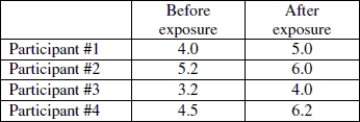A researcher wants to know if mood is affected by music. She conducts a test on a sample of 4 randomly selected adults and measures mood rating before and after being exposed to classical music. Test the hypothesis that mood rating improved after being exposed to classical music. Following are the mood ratings for the four participants:  Assume that all conditions for testing have been met. Report the null and alternative hypothesis and p- value. At the 5% significance level, state your decision regarding the null hypothesis and your conclusion about the original claim. Round all values to the nearest thousandth.
Assume that all conditions for testing have been met. Report the null and alternative hypothesis and p- value. At the 5% significance level, state your decision regarding the null hypothesis and your conclusion about the original claim. Round all values to the nearest thousandth.
A) H0: µ1 = µ2, Ha: µ1 × µ2; p = 0.008; Fail to reject the null hypothesis; there is not strong evidence to suggest that exposure to classical music improved mood rating.
B) H0: µdifference = 0, Ha: µdifference < 0; p = 0.008; Reject the null hypothesis; there is strong evidence to suggest that exposure to classical music improved mood rating.
C) H0: µ1 = µ2, Ha: µ1 < µ2; p = 0.077; Fail to reject the null hypothesis; there is not strong evidence to suggest that exposure to classical music improved mood rating.
D) H0: µdifference = 0, Ha: µdifference > 0; p = 0.922; Fail to reject the null hypothesis; there is not strong evidence to suggest that exposure to classical music improved mood rating.
Correct Answer:
Verified
Q14: Choose the statement that is the best
Q15: Suppose that the average country song length
Q16: Suppose a consumer product researcher wanted to
Q17: Use the following information to answer the
Q18: The reading level of a random sample
Q20: The weights at birth of five randomly
Q21: An economist conducted a hypothesis test to
Q22: Suppose that the average song length in
Q23: Use the following information to answer the
Q24: Use the following information to answer the
Unlock this Answer For Free Now!
View this answer and more for free by performing one of the following actions

Scan the QR code to install the App and get 2 free unlocks

Unlock quizzes for free by uploading documents